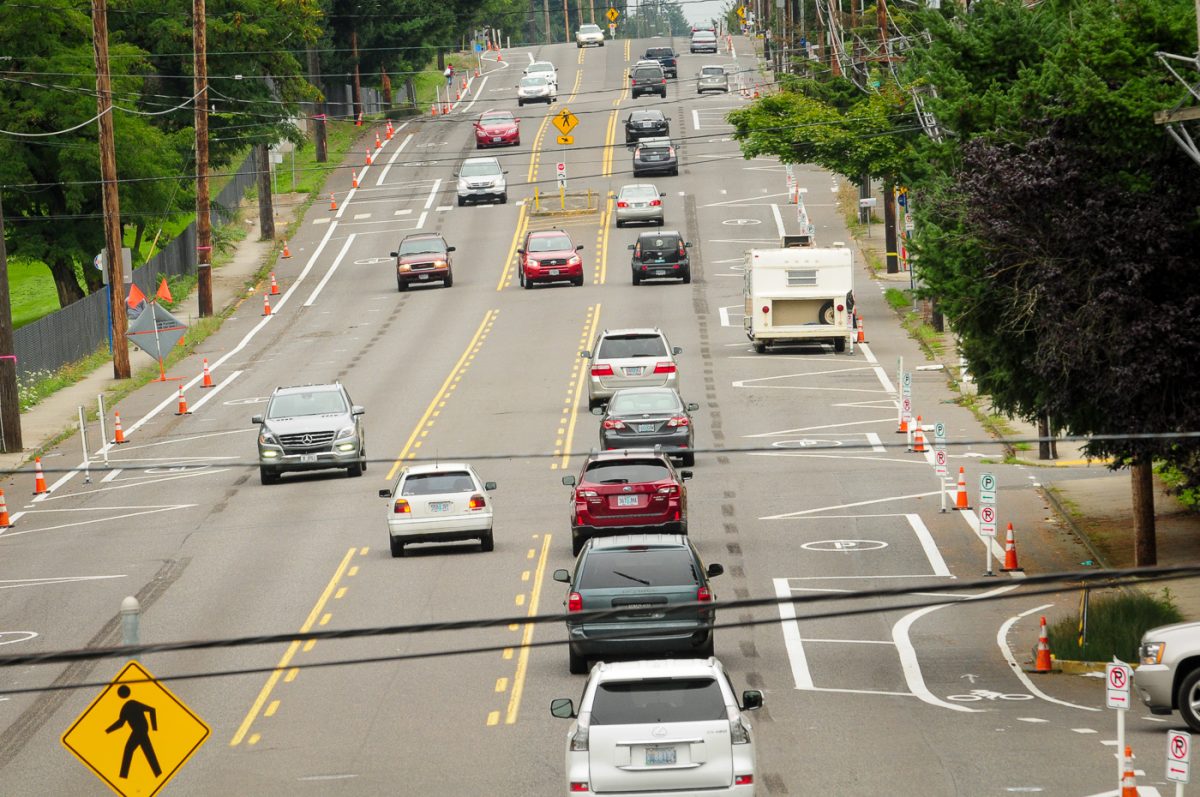
(Photos: J. Maus/BikePortland)
The latest project in the City of Portland’s systematic approach to redesigning arterials east of 82nd Avenue* is the East Glisan Street Update. The project focuses on the segment of Glisan between I-205 and the Gresham city limits (NE 162nd).
With a significant portion of the changes already on the ground and/or under construction, I decided to have a look at how it’s shaping up.
The Portland Bureau of Transportation (PBOT) prioritized about $400,000 worth of changes on Glisan because of its history of speeding and crashes — which should come as no surprise when you see that it’s previous design was essentially a neighborhood freeway. It had five driving lanes and unstriped shoulders on both sides where people could park their cars on the curb. It was wide and fast and terrible for everyone outside of a car.
In fact, it was terrible for people in cars too, judging from the jaw-dropping collection of photos on the PBOT project page showing the abundant damage to life and property that’s been caused in recent years by drivers. The images below were sent to PBOT from people who live in the project area on Glisan…
PBOT’s solution was to restrict car use to one lane in each direction and a center turn lane and add bike lanes in both directions. In addition to this new striping, they’re working on even more robust treatments near two elementary schools (Glenfair and Menlo Park). As of yesterday, striping is mostly complete from 122nd to 162nd. PBOT says they’ll be working through October to finish a new crossing and related changes in front of Menlo Park Elementary (at 128th).
From my relatively brief observations and experiences yesterday, the changes seem to be working well. It was quite nice (almost revelatory) to ride my bike in a lane with a generous buffer from auto users. As is always the case with projects that dramatically alter how a street is used, I expect people to behave a bit erratically and have some anger or sadness about the changes. I am also not surprised when a local media outlet exploits these feelings to broadcast biased and sensationalized coverage that aims to do nothing other than stoke flames of hate among neighbors and distrust of government that are making it difficult for us to make progress on many challenging issues we face. But I digress…
Advertisement
Let’s take a closer look at the new striping shall we?
First, here’s a little video from a biking perspective…
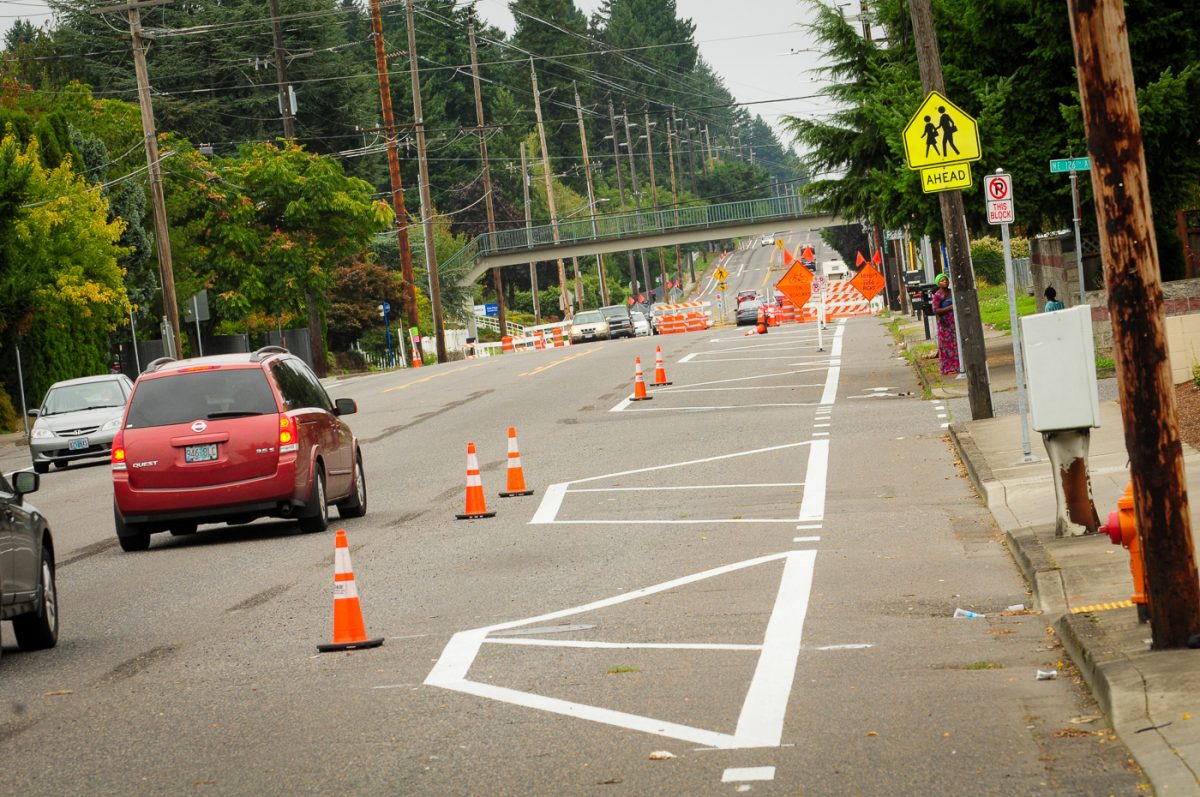
By now you should be familiar with how PBOT designs these parking-protected bike lanes. They shift the auto parking into the roadway and add it to buffer striping and plastic posts to create a protective buffer between auto users and bicycle users. It’s great to have space between modes; but I’d rather get the auto parking lane (which is often wider than the space for cycling) completely out of the picture. As you can see in images below, a five-foot wide bike lane against a curb can feel narrow when it’s hemmed in by parked cars, bioswales, storm drains and debris (that isn’t swept away as often as other lanes).
The most noteworthy part of this project is outside of Menlo Park Elementary between 128th and 130th. PBOT is constructing concrete curbs to protect bi-directional bike lanes and a floating transit stop. They’re also adding a flashing beacon crossing and lots of green and white paint. Below are shots of the new curbs and the view looking west from the footbridge in front of the school (a footbridge that will stand as a symbol of how much of a design failure Glisan was for decades).
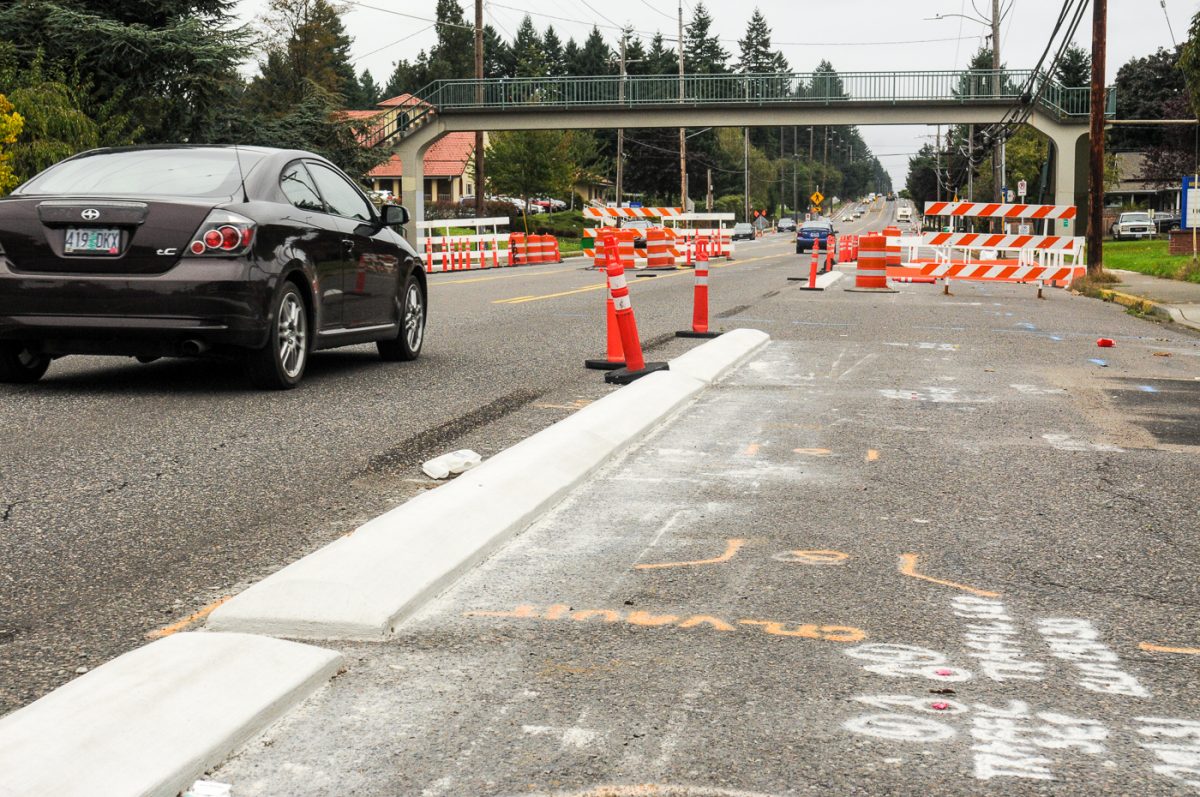
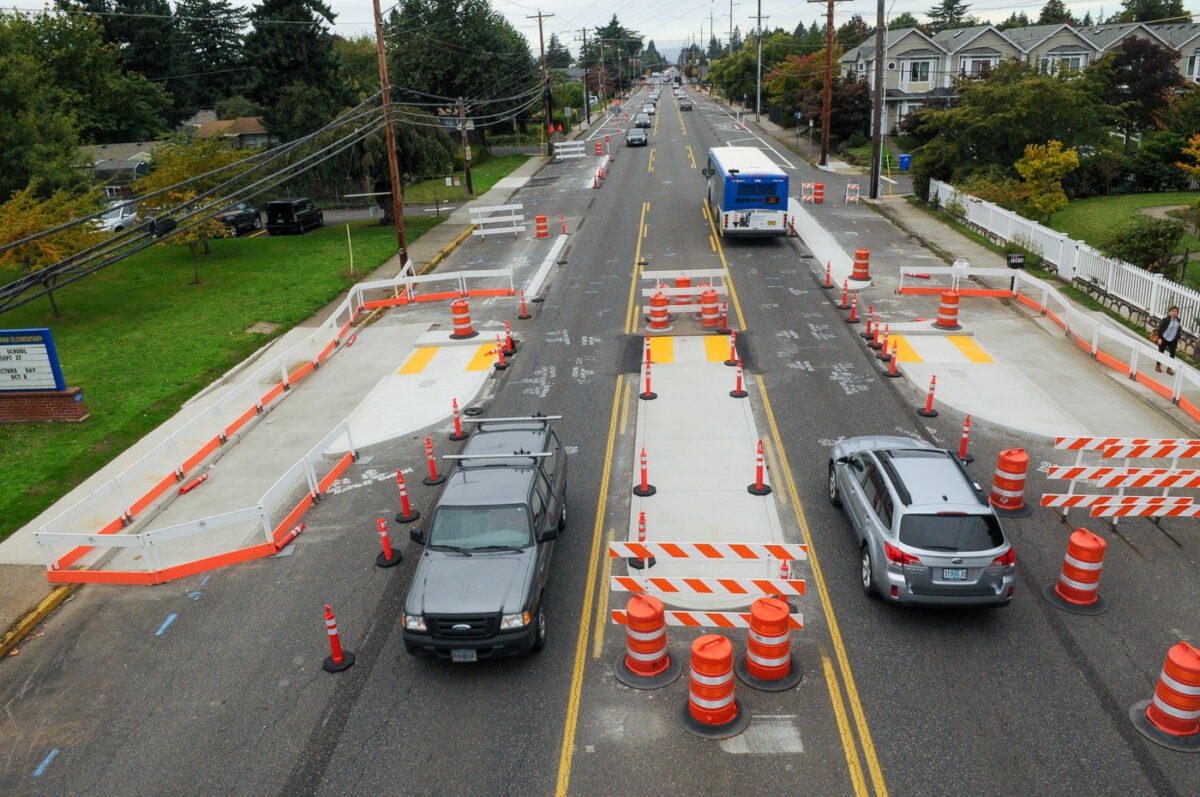
Overall, I think it’s wonderful how PBOT has created a safer and more fair allocation of space on this street. Especially given that it goes by two elementary schools where it’s so imperative for people to have an option other than driving.
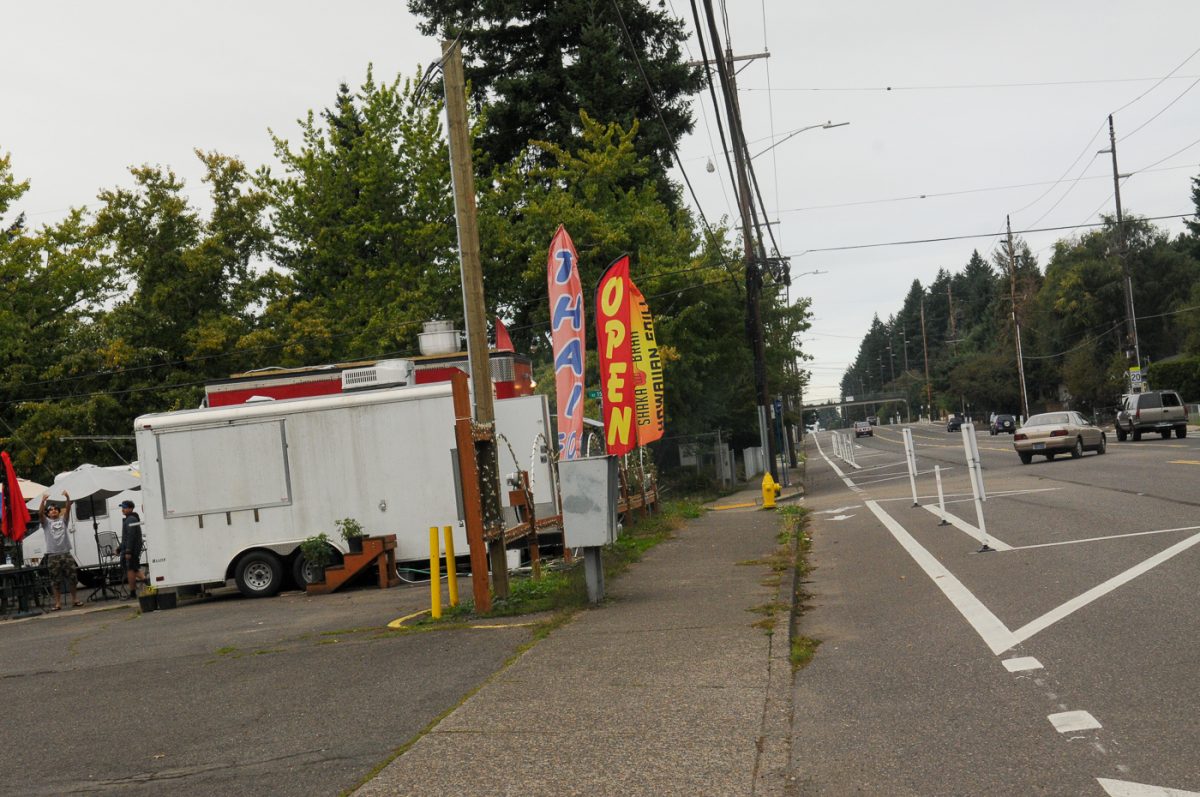
Toward the eastern end of the project is a small food cart pod. It’s very likely that a more humane street — one that’s now even more accessible by a cheap, traffic-proof, emissions-free vehicle — will lead to more business and less stress for everyone.
Speaking of stress, and the angry men interviewed in the KATU-TV piece, PBOT’s Hannah Schafer said they have no plans to back away from these changes. I asked her about the project yesterday. “We know some people are struggling with the changes; but we are committed to studying it and seeing what happens,” she said. “We have a responsibility for safety in our city and that’s our job as the transportation bureau: To make sure our streets are safe, so we’re going to do that to the best of our ability.”
One last thing: While we quibble with design specifics of these projects (102nd, Halsey-Weidler, N Rosa Parks, and so on), I firmly believe the positive impacts they’ll have on safety and biking in the long term will be profound. From bus-only lanes downtown to fewer driving lanes in east Portland, PBOT is slowly but surely whittling away the supremacy of the automobile.
Have you ridden Glisan before or after the changes? What are your impressions?
*Learn more about PBOT’s East Portland Arterial Streets Strategy (EPASS).
— Jonathan Maus: (503) 706-8804, @jonathan_maus on Twitter and jonathan@bikeportland.org
Never miss a story. Sign-up for the daily BP Headlines email.
BikePortland needs your support.


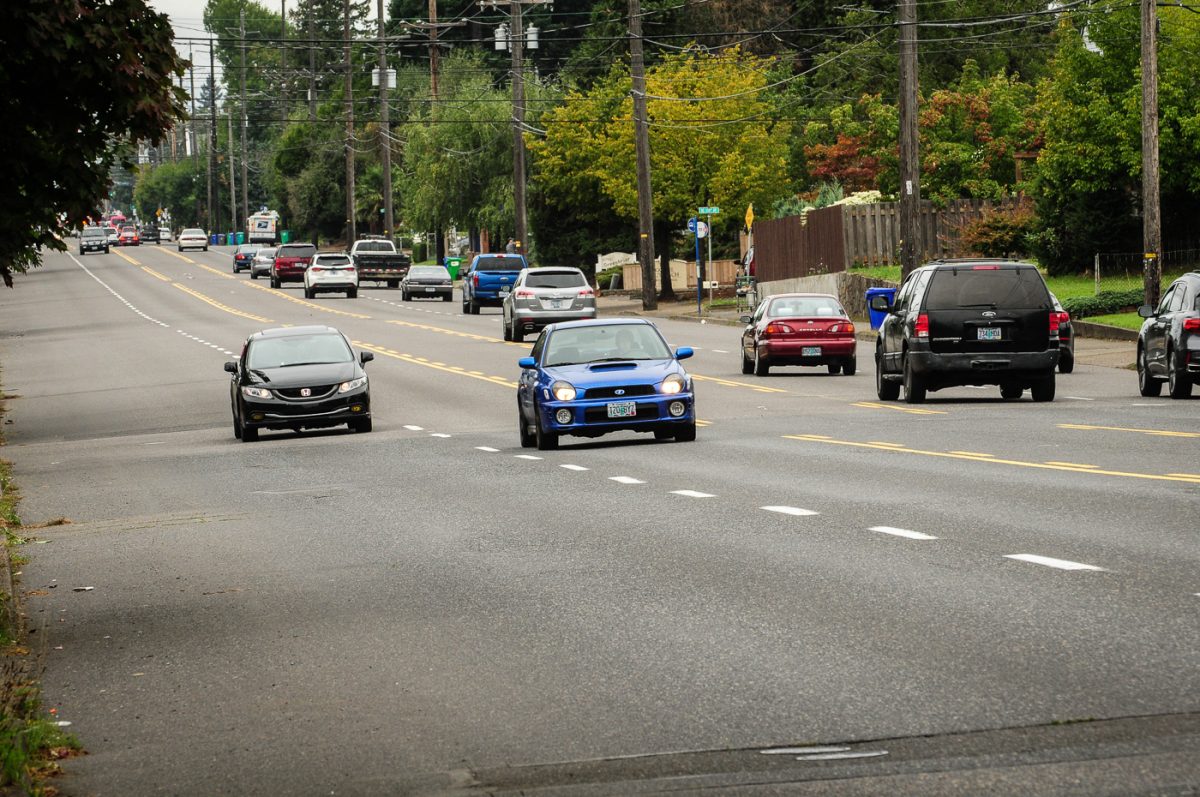

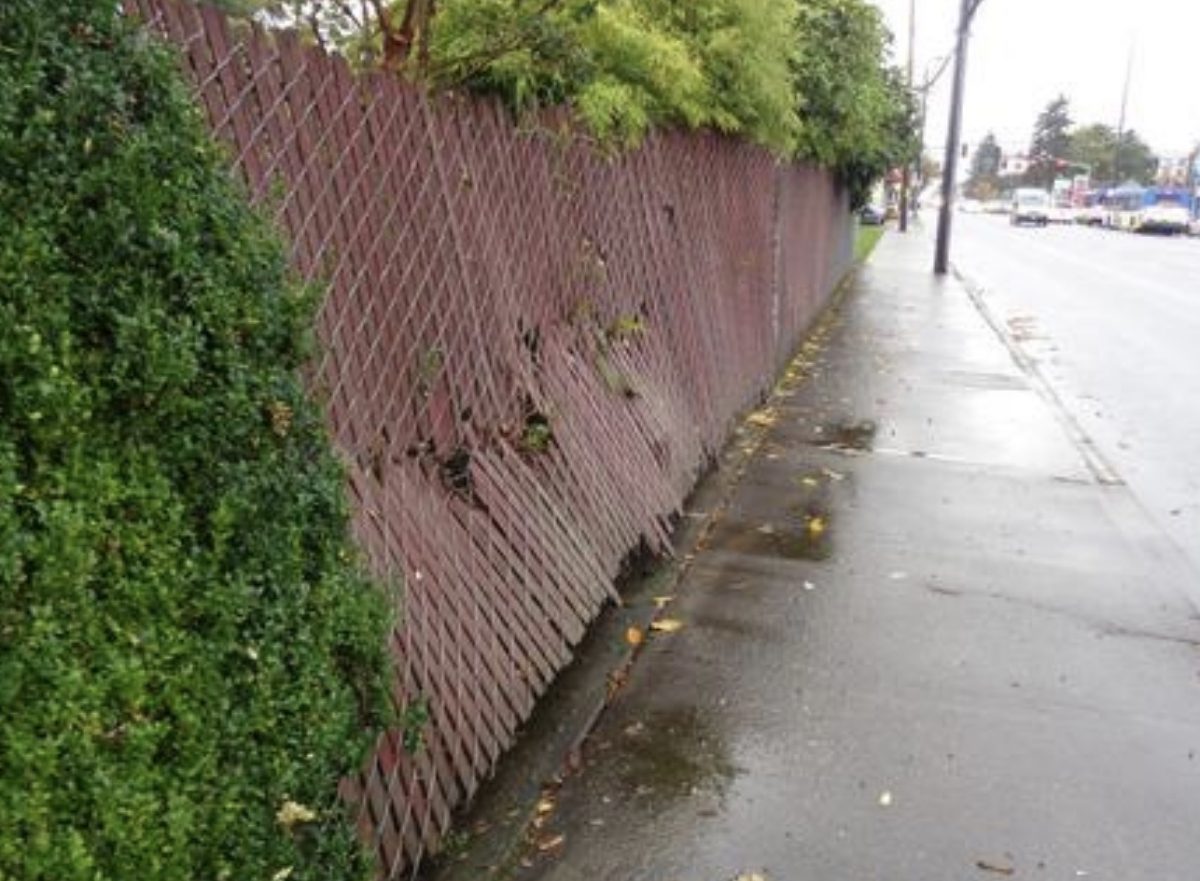
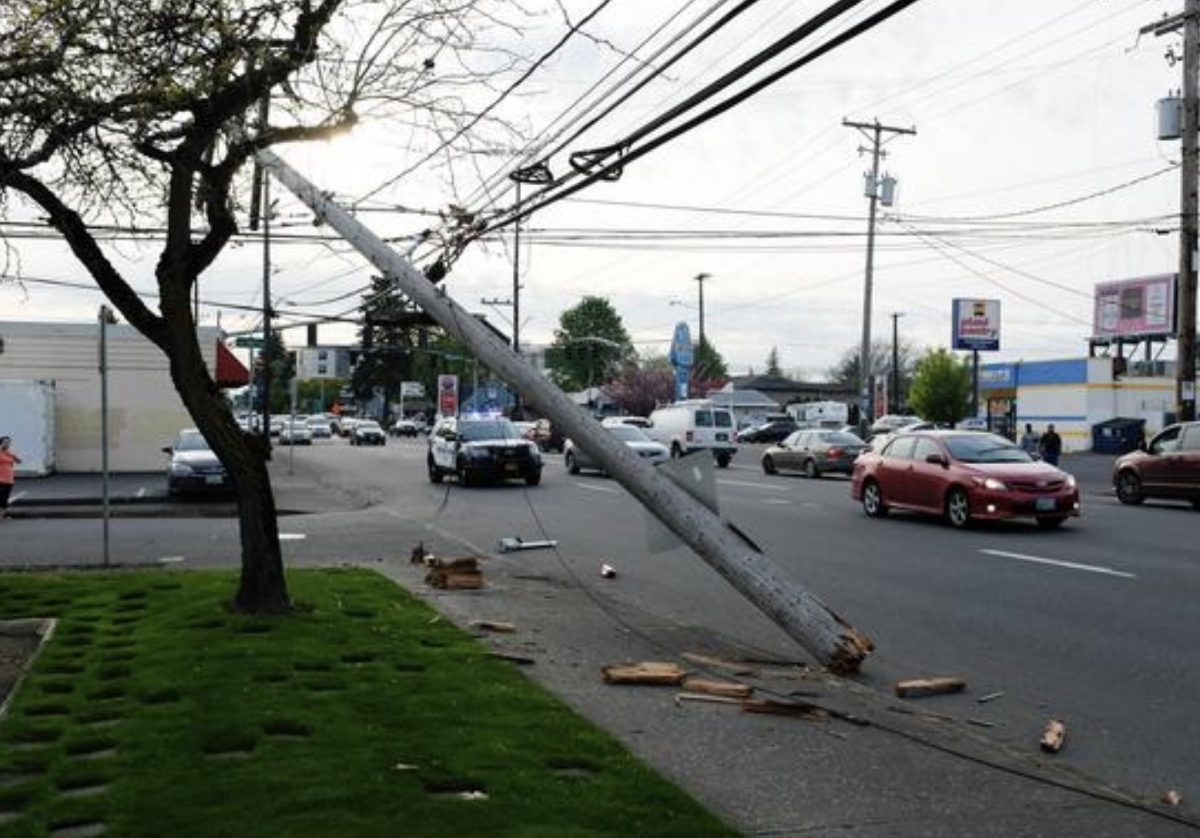

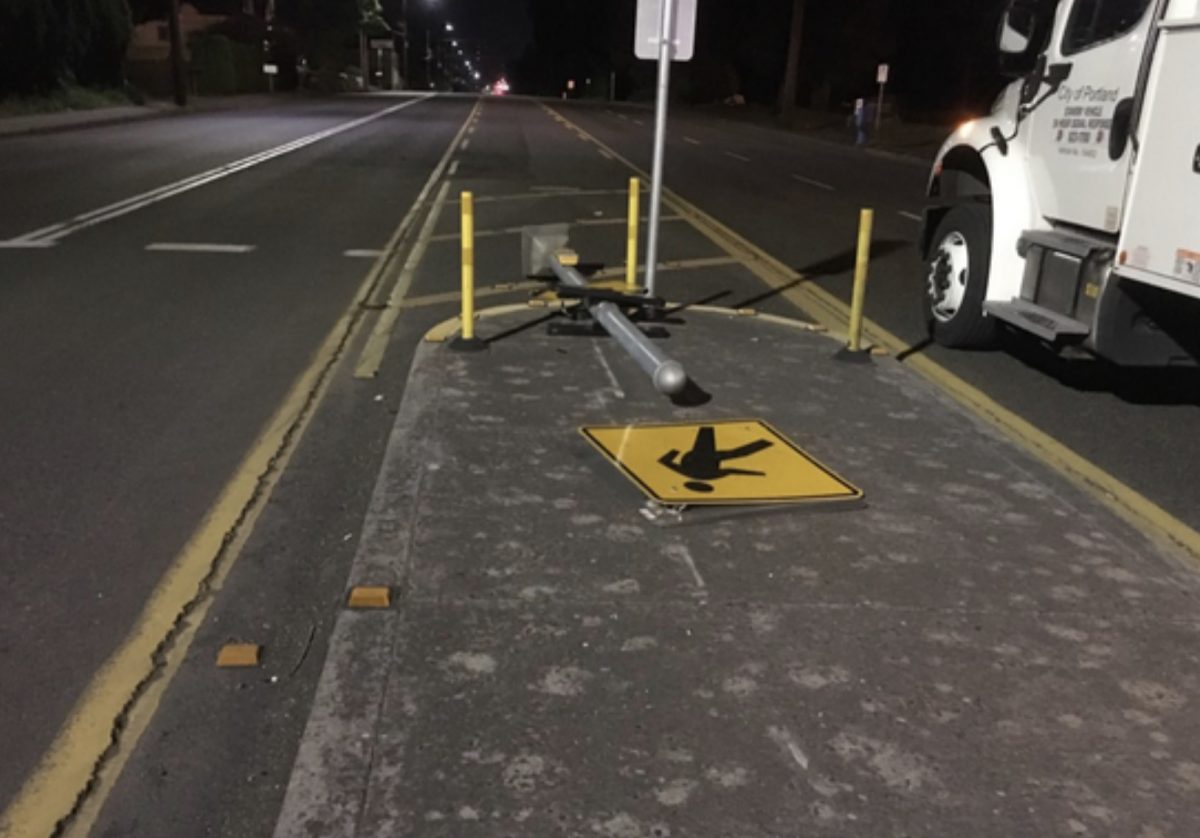
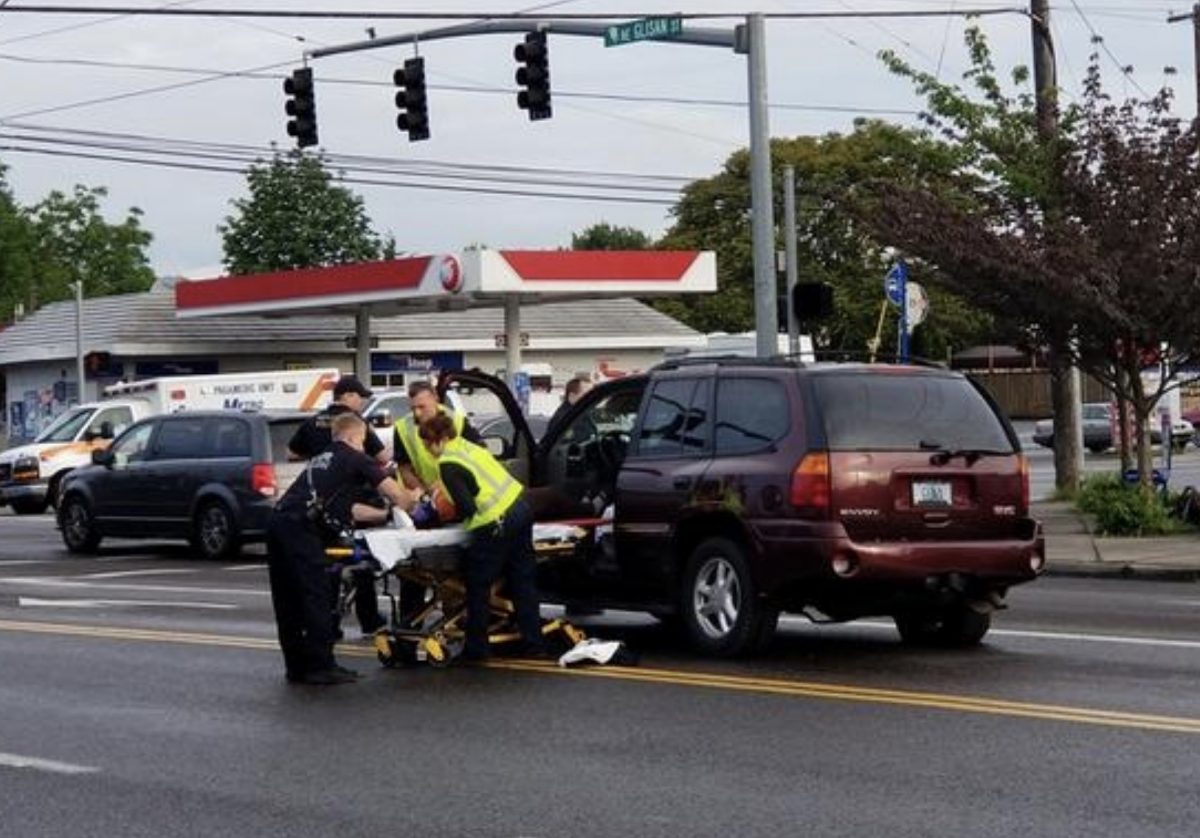

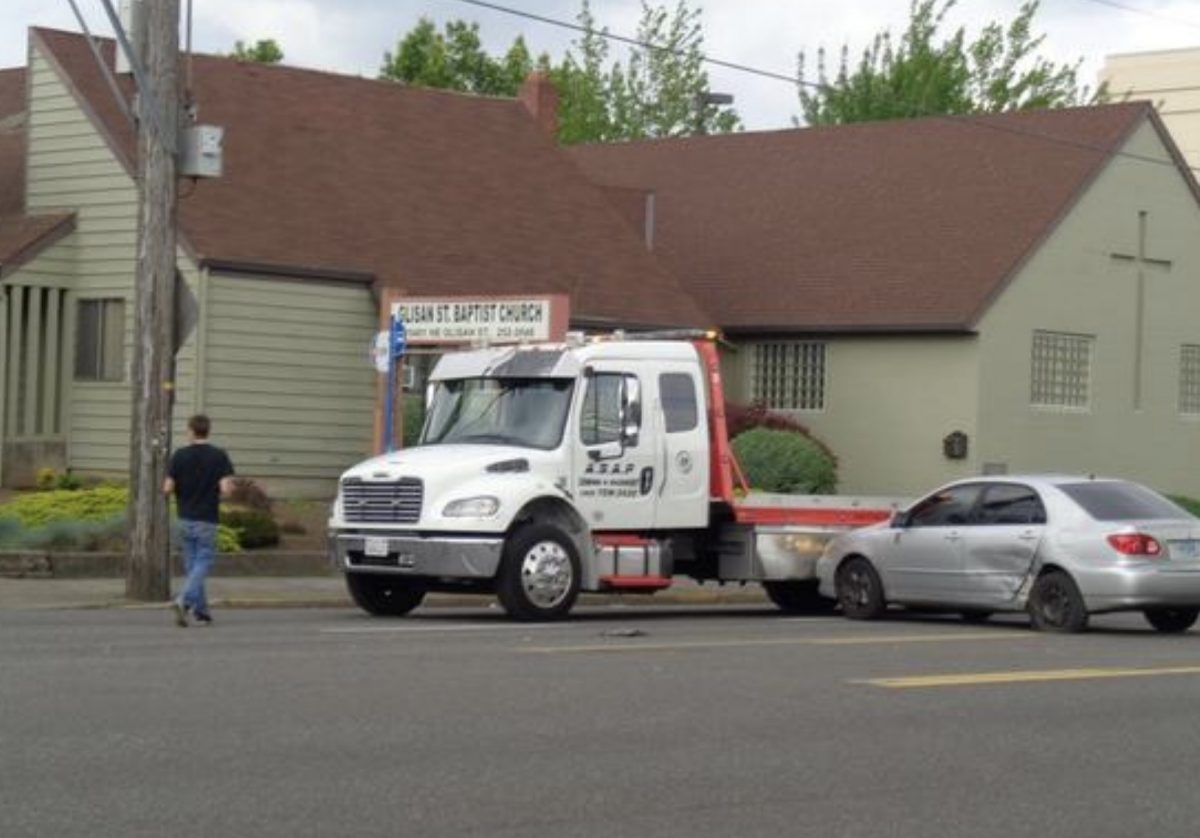
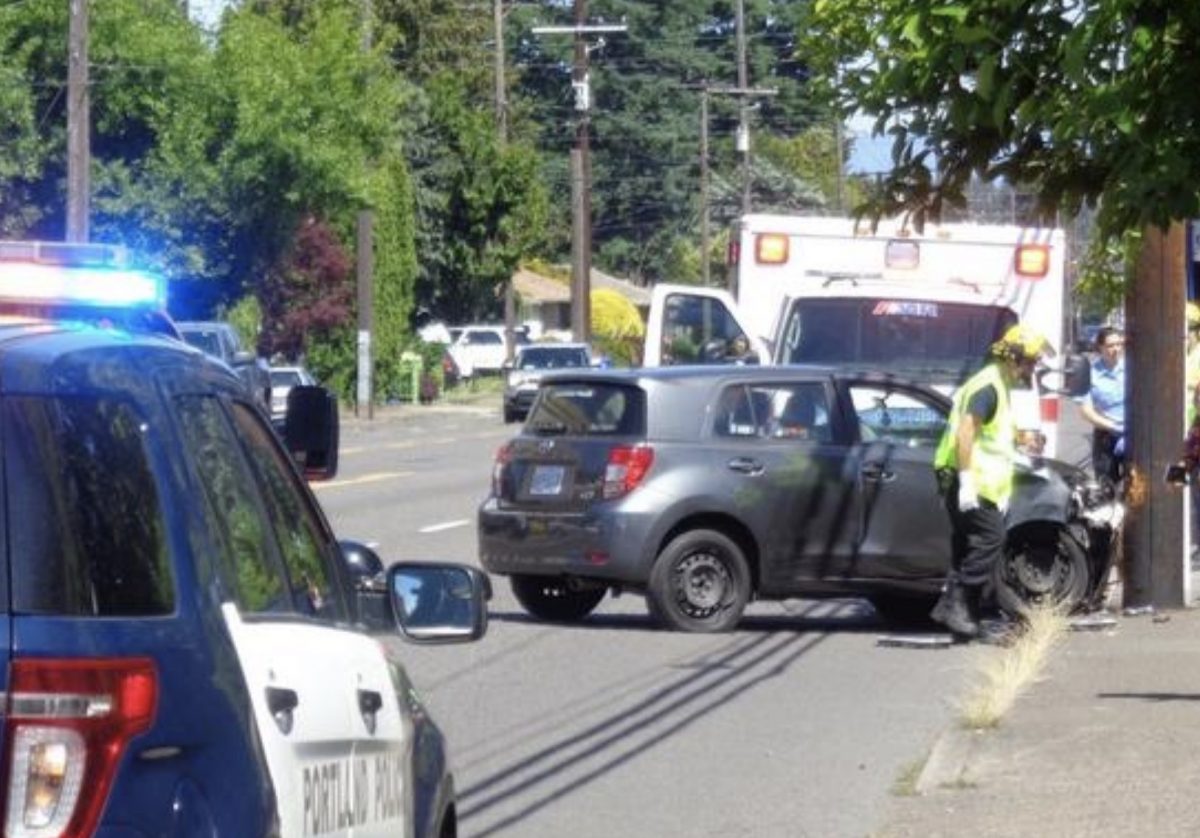
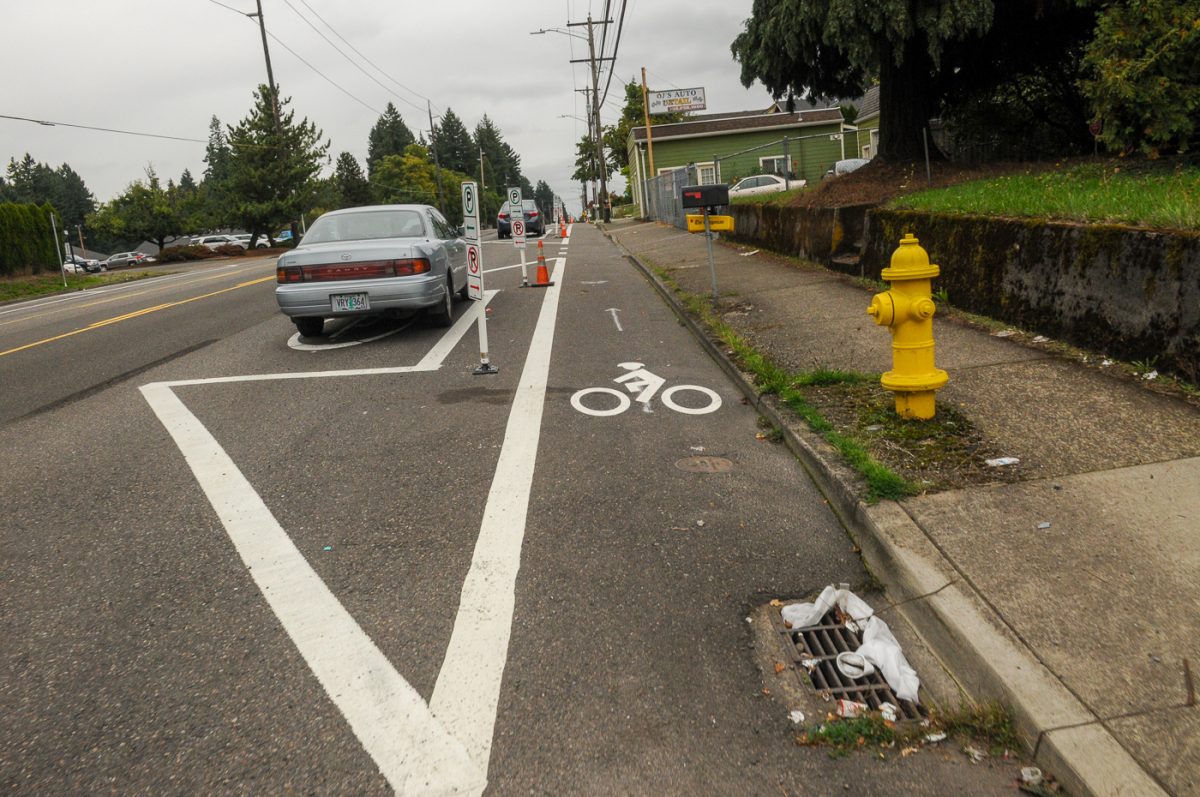
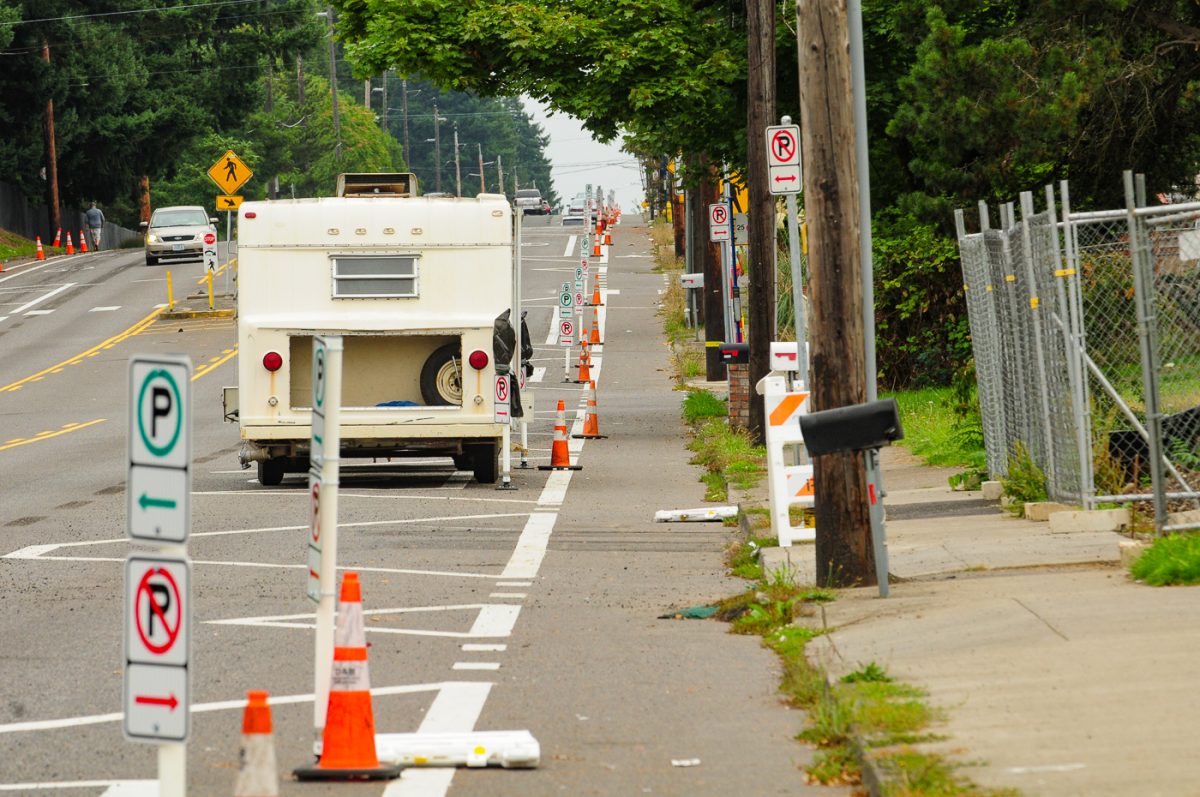

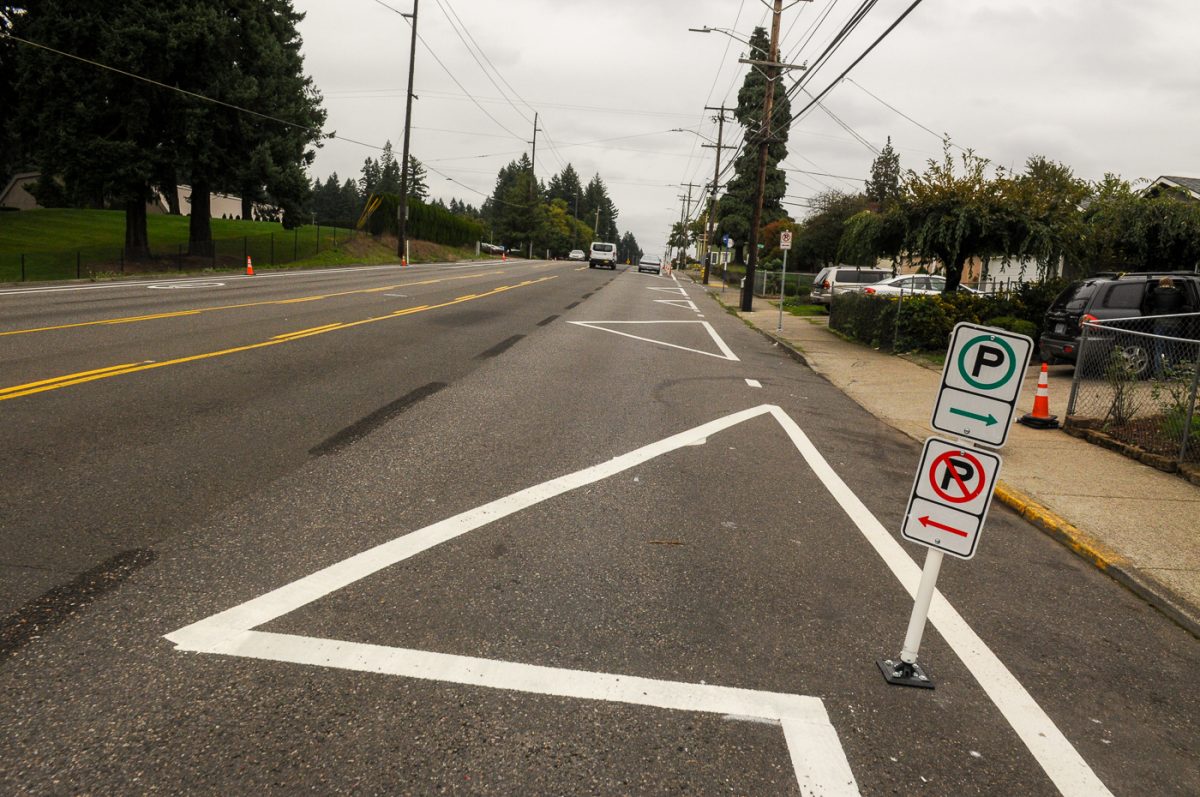
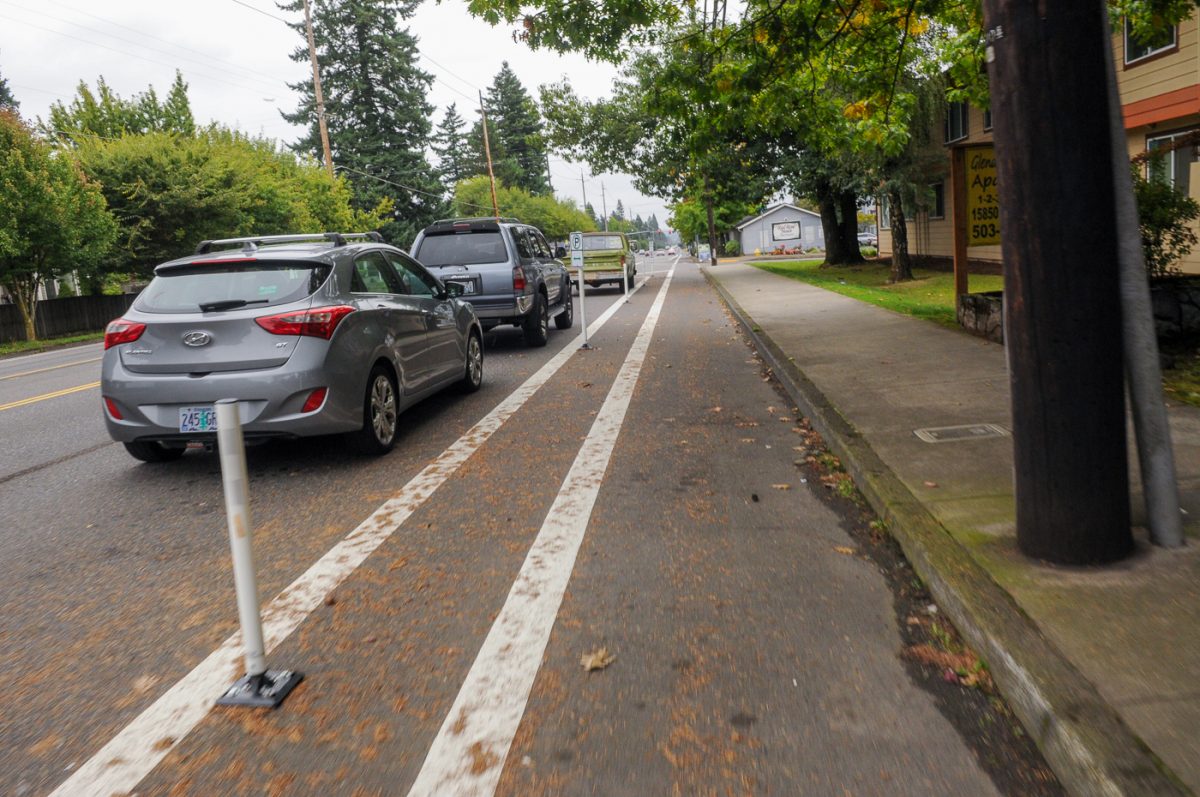
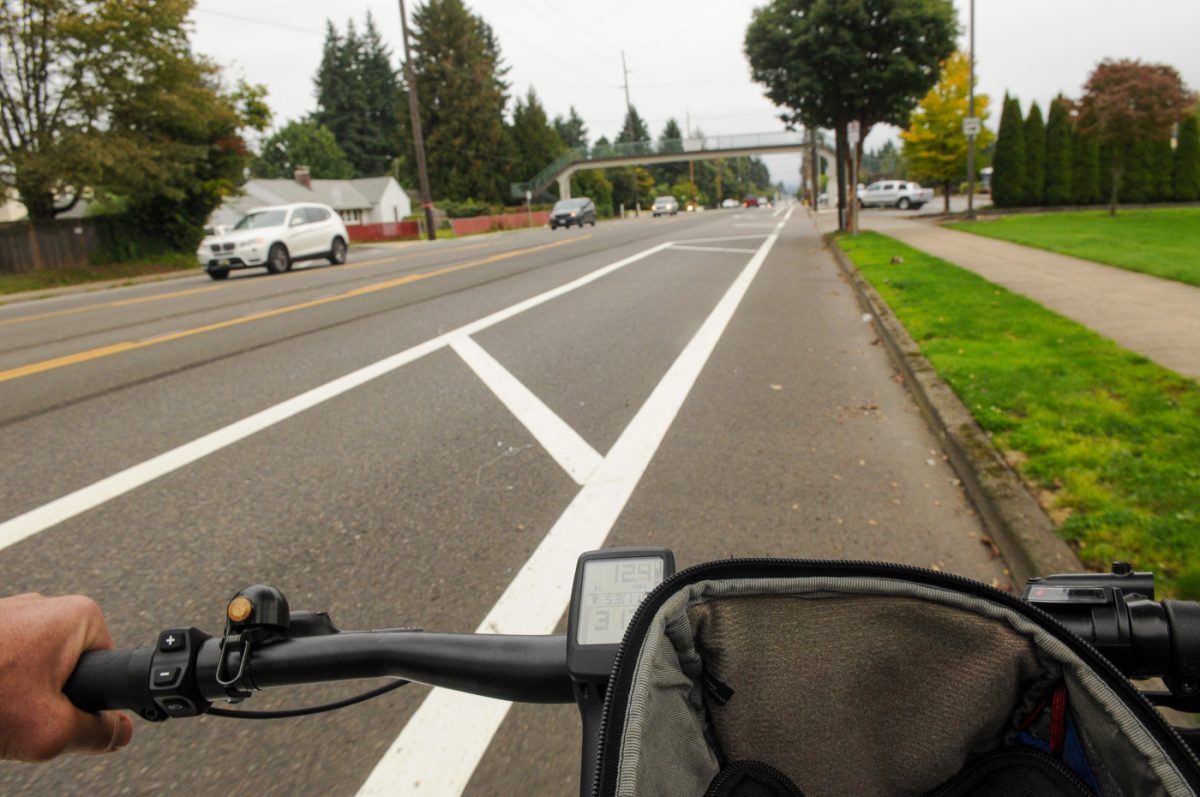

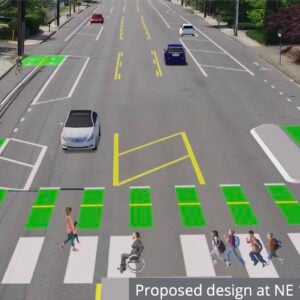
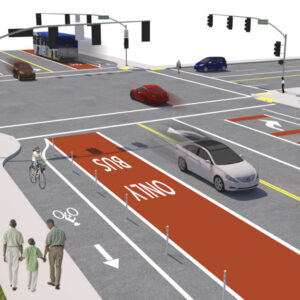
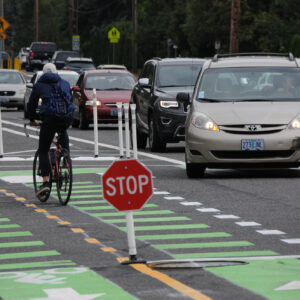
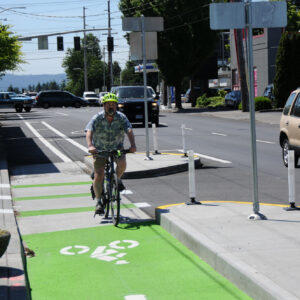
Thanks for reading.
BikePortland has served this community with independent community journalism since 2005. We rely on subscriptions from readers like you to survive. Your financial support is vital in keeping this valuable resource alive and well.
Please subscribe today to strengthen and expand our work.
Glisan has been very much NOT SAFE in the past. I live in the area and have always used Burnside or Halsey instead. The louder people in the neighborhood are NOT happy, but I think long term it will make things better. What we also need, though, is decent transit. Bus 25, which runs on Glisan, is very INFREQUENT service — more than an hour between buses, last time I tried to use it. Line 73 service on 122nd is better, but still not as frequent as buses headed to downtown.
Hi Kathleen,
Nice to hear from you! (Some of you might recall that I did a Ride Along with Kathleen back in 2014).
I’m glad you appreciate the changes. And I hear you about transit needs. I hope TriMet is aware of this need and that we can get better service on Glisan soon. Not sure if it applies to Glisan, but I know that PBOT worked closely with TriMet on 122nd. The deal was: TriMet promised to improve service but only after PBOT made transit access safer. From what I know, both agencies came through. Perhaps you can work with your n’hood association or OPAL to do something similar now that Glisan has been updated.
Keep in touch and hope to bump into you again soon.
Does anyone like the bike lane between the curb and the cars? No one I know does, cyclists, cars, pedestrians. I don’t usually read the comments here so I don’t know what the general thought on these is but I can’t stand them, I’d prefer the old school “unsafe” version. Planners seem to generally make what seem like terrible decisions for bike traffic by making most new designs completely indecipherable to someone going bike speed on a bike.
If they do this like they did Foster, then traffic will be a lot worse. They effectively removed almost all left turns for eastbound traffic in the first 20 some blocks on Foster by putting pedestrian shelters on the west side of the intersections.
Yes. Especially on a wide street like Glisan I would much rather be cycling between parked cars and pedestrians than between parked cars and moving cars.
To be fair PBOT hasn’t yet built any particularly great examples yet. Ideally we’d be building examples of this quality: https://goo.gl/maps/WnYzDaAs3891myhN8
I also MUCH prefer being separated by moving traffic. I’d much rather use separated cycle tracks (separated by objects and not just separated by paint) like at the lloyd center or PSU or NE Cully.
That’s what they call “grade separated”. The only example we have of it is on Cully.
The cycle track along Multnomah between Lloyd Center and Rose Quarter is my main experience to “between parked cars and curb,” and I like it. (This strip absolutely does have parked cars among the weird planters.) As others have said, I much prefer to be between parked cars and the curb than parked cars and moving traffic.
I agree it’s great, at least until you hit a driveway or cross-street and a driver who can’t see you turns across your path. This problem can be designed around by restricting parking upstream of such a turning opportunity, but in many cases isn’t (see SW 2nd for example). In areas with many driveways, it would probably necessitate removing most or all parking, which somewhat defeats the purpose of parking protected bike lanes.
Yes, the threat of the right hook is what I’m thinking about 90% of the time that I’m biking downtown from NE Portland, including on Multnomah. It’s great that the Glisan project is taking a lane away from motor vehicles, but the right-hook potential would make me really nervous if I was biking there. Too many driveways and cross streets.
I truly despise this sort of implementation and will ride an alternate route if at all possible. Each driveway is an invitation to a right-hook. Each intersection presents far too many hazards from all directions with cyclists being invisible, and those narrow spaces and constant little turns around obstacles simply don’t work for those many times I drag a large cart or ride a tandem or triple.
It would have been far better to put the parking on the curb and buffer the bike lane from it so that it’s not in the door zone. Failing that, they should have widened the bike lane by moving the parking lane tighter to the travel lane and also removed many of the parking spaces. That would be a step towards removing all of the parking so that a bus lane can be put in.
Facilities for motor vehicles are generally designed to work for all vehicles. Why are facilities for bikes designed to only suit those who ride single bikes, very upright, at 8 mph? Is it any wonder PDX can’t grow its cycling modal share? Compromise facilities for motor vehicles such that only so-called Smart Cars can fit in them while being driven 15 mph and I bet the motor vehicle modal share shrinks in a hurry.
I have to agree with Mr Carfree: much better to put the parking against the curb and then put a buffer in the door-zone. My reasoning:
– Crossing traffic from the right is a serious hazard. Cars that don’t really stop anyway now really can’t be bothered to stop, since they know they have to move beyond the bike lane AND the parking lane to make the turn.
– Bikes are pushed right against the curb, leaving less reaction time for drivers and cyclists.
– Cars turning left across the parking lane and the bike lane can’t see bikes behind the parked cars, esp the fast-moving bikes.
– Buses still need to move to the curb, trapping bikes behind them with no good way to move around the bus.
The center turn-lane and the single vehicle lane in each direction are really helpful in slowing down traffic and making the street safer for everyone.
Jonathan, I hope you can ride up to SW Capitol Hwy and see the new treatment from just south of Barbur to the Lake Oswego city line. PBOT has built a huge buffer in several places, apparently to allow a sweeper to clean the curb-lane slash bike-lane. I’ve ridden it a few times and have been pretty impressed with how much calmer it feels. The only thing I don’t like is the downhill stretch where the bike lane has been pushed against the curb. I’m pretty sure a cyclist will meet on a crossing car on this stretch, fairly soon.
I ride that stretch of Capital highway on my commute! The improvements are wonderful!
It’s also a great example of a street that never needed to be four lanes in the first place.
The new design just fits the neighborhood so much better.
Pbot should take this approach with any road that goes from 2 to 4 back to 2 lanes.
Yes!
I remember riding back to inner SE on Glisan from a Pedalpalooza MMR that went to Gateway Green in 2010 or so? We left the party and took the 205 path south to Glisan. It was 4 or 5am and there weren’t any cars on the road. Cruising back down towards the river was amazing on a straight-shot road. Then got to Sandy and just kept rolling. I haven’t ridden on Glisan since… I’ll maybe ride it for 1/2 a block from the 205 off-ramps to 94th, then cut into the neighborhood. It’s great seeing these improvements happen east of 102nd, I just wish they’d been able to do a better job tying them into the 205 path. Yeah, I know, people in cars and traffic and ODOT and 18-wheeler turn radiuses didn’t like the ideas. Maybe someday they can fill in the gap from 102nd over 205 to 82nd. The downhill from 205 to 82nd is yet another speedway.
between 205 and 82nd is the stretch I’m on most frequently. I also hope this treatment gets extended west.
in the video, 26 seconds in, that is a stupid design for a right turn lane. The bicyclist is obstructed from a driver’s view, and the bicyclist has to triple check no driver is moving right, while biking around the curve. The driver is probably not looking, and didn’t see the bicyclist because they were behind parked cars. The turn lane should be 10 feet further up.
1:02 there’s excess shoulder space. I wonder they it wasn’t just included in the bike lane. People are going to think they can park there (even though there’s a no parking sign).
The number of painted triangles here is wild. And PPBL don’t work if no one is parking… Seems like a better use of the parking here would be for transit lanes.
There’s now lots of guidance for better intersection design.
https://nacto.org/publication/urban-bikeway-design-guide/dont-give-up-at-the-intersection/
https://www.mass.gov/files/documents/2017/10/26/SeparatedBikeLaneChapter4_Intersections.pdf
Dang, I wish I had bought stock in street-paint companies!
To think of how many pounds of plastic and gallons of paint went into this sustainable, elegant, and beautiful solution …
The vehicular cycling lobby always shows up…
Please let us know when they do. Wanting bike lanes to be more visible is not “vehicular cycling”.
It’s not vehicular cycling, it’s simple common sense that makes me not to want to ride in the gutter, where all the trash and water accumulate, where the poorest pavement and the most utility cuts are found, and where the turning motorists can’t see you.
Did I forget to mention the sunken curbside double-wide sewer grates BES insists on, that can narrow the bike lane to inches and/or cause you to crash? No one in their right mind wants to ride in these conditions! The rise of electric bikes just makes these facilities more dangerous, since E-bikes are going faster.
It’s created enormous backups of idling traffic polluting the air, so there’s your trade-off.
Not really.
Man oh man! We better cover over those buffered bike lanes right now before someone dies and get them back in traffic where they will be safer!
Get those pesky bike riders out of the sight of cars.. segregate them into a winding, narrow, trash filled obstacle course, to emulate the sidewalk riding that is the epitome of Portland cycling . But to be realistic, nobody will use it anyway. Eliminate pull ins for buses so that they can bring traffic to a standstill. Brilliant
Do you shill for the car industry? Versa car sitting and idling don’t burn a lot of fuel. In fact most of the fuel is actually burned when a car is under heavy acceleration. second if a car is sitting in idling a moving slowly it’s not running somebody over.
What will happen over time is that people will adjust and take other routes or they won’t drive it all at that time.
traffic jams are a function of people over using a particular road. now they have a choice whether they can drive or ride.
So you can put away the trope about cars idling and polluting. We see right through it. Tata for now!
Wrong. More lower income folks out here means not everyone is driving the latest and greatest automotive technology. There are a lot of older, higher polluting vehicles. Maybe you could venture out of the safety of the inner city and come out and see for yourself. Ciao!
Toby, how can we get those lower-income folks out of those polluting cars and onto bikes? Why do we assume that driving cars has to be the “given” situation?
Because it is?
Don’t expect any solutions from him. He just rants here.
Let’s see here….a sewer grate which I can avoid or a semi truck running over me and ripping my legs off? So many choices. hey look on the bright side you are still free to ride right in traffic.
If you’re that afraid, maybe you shouldn’t be on a bike after all.
And actually, you’re not ‘still free to ride right in traffic’, since Oregon has a mandatory sidepath law and cyclists have no more legal protection to ride in traffic once one of these abominable facilities have been built. If PBOT wants to keep building this crap, they should be lobbying for repeal of the mandatory sidepath law in Salem first!
BTW, the hardscape hazards in the built environment are real and present 24/7, and I’m pretty sure they cause more injuries to cyclists than motor vehicles do, when you add up all the cyclists injured by the streetcar tracks, curb extensions, sunken drainage grates and whatnot.
Part of my commute got a pinch-point…. sorry, swale treatment last summer. Good thing I can keep pace with cars on that stretch… until they see my cyclist butt and decide to whip around me regardless of speed and the fact that’s it’s a residential neighborhood… I didnt think my butt looked that bad!
I wonder if theres any way BES or PBOT or whomever has authority over storm drains could change the orientation of the grates. As they are, they’re great tire grabbers.
This is the kind of inclusive attitude that is going to help us grow our cycling participation in this city…
We are truly entertained that you believe a fixed object that is the same place every day, never moves and doesn’t theater anyone has/will damaged more people than a car. It’s almost like watching a drunk defend their right to have a liquor store on every corner.
Look, you are just plain delusional. Do you have kids? If you do, feel free to ride them on this lane or find a street with the detective door stale lanes and take them there with cars right off your wheel. I don’t care. They are your kids(if you even have any).
As to your point about the mandatory side path law, who cares? Are there a dearth of cops enforcing it? I get pulled over once a year form breaking some arcane car law and you know….I just smile and apologize. And the cop lets me off…..try that sometime with these mean cops always busting you for not using a bike lane.
But I appreciate there is always one (well Kitty too, but I don’t count her because she is always on the wrong side) that advocates putting more kids in the street next to cars.
The point of the sidepath law is not to give officers an excuse to pull you over; as we all know, there is effectively zero traffic enforcement in this city. The law exists to assign blame in the event of a crash. When a careless motorist crashes into a cyclist and seriously injures them, the driver’s lawyer will certainly call them out for not using whatever sub-standard facilities are present.
Exactly my point, this is just another example of a PBOT-designed and built substandard facility!
Are they planning on putting any green thermoplastic down on those blend areas? It seems like all the dashed areas need that treatment.
I have ridden and driven the area now. Anyone have thoughts about the two motorized lanes coming together (as in arrows for right and left point to the center) versus a typical right lane ends ahead. Watched drivers get pushed into the parking area at every junction by drivers in the adjoining lane. Anyone know if there are plans to do this on the west side of 205?
Look at all the glorious free parking!
Such a waste.
I love that the paint is barely dry, and there is already a junky RV parked on the street. Don’t expect that to move any time soon…
As a long time resident of the East Glisan area south of Glendoveer, these changes seem to be an accident waiting to happen. There is no longer breaks in the traffic to allow traffic from side streets to enter Glisan. I feel that drivers and bicyclists alike are taking chances they normally wouldn’t. Could there been something in between the “neighborhood freeway” and the current solution to try out first? Maybe some more experienced cyclists are OK with the changes. The vehicle right turn options at side streets and driveways totally freak me out as an occasional bike rider. Ironically, while PBOT is making these changes and bringing traffic to a crawl, the Bureau of Planning and Sustainability is increasing density by tenfold in this same region.
Experienced cyclists know this won’t work and don’t want to use it. They are trying to attract inexperienced cyclists who don’t know any better with this facility.
Attracting inexperienced cyclists SHOULD be the policy! We need to add to our numbers. I hope you don’t quit cycling because of the new infra.
The best way to slow speeds is to narrow the roadway and reduce to 1-lane. 2-lanes in each direction encourages passing, speeding, etc. The other option here would have been to maintain all curbside parking and have a buffered bike lane and 3 travel lanes (one each way, and a turn lane). The problem with this design is that people will use the bike lane to speed past traffic, or to make turns. It also doesn’t solve the “stream of traffic” problem for people coming out from side streets.
So I once found myself eastbound on that stretch of Glisan, and had the rather unpleasant/terrifying experience of riding past Glendoveer – a section that doesn’t even have a sidewalk. So what’s the treatment on this stretch? A parking-protected bike lane? That’s not going to work well, because people will want to walk there, now that they can do so without being flattened by motor vehicles. Seems to me there needs to be a Better Naito-ish sidewalk/bike lane combo on the north side of the street through that stretch.
Some will point out that there is a narrow sidewalk on the other side of the street, which is true. But the problem with that is that you have to cross the street to get to it. Having a sidewalk on only one side of a busy street is unacceptable.